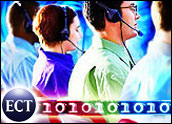
The need to support a 24/7 global environment has forced companies to reinvent how they approach the various components of a successful call center.
Determining the right combination of people, processes and technologies is critical to the effectiveness of the virtual call center — a call center that functions in every respect as a single logical entity with agents that are physically distributed across multiple locations.
Distributed Agent Strategy
An integral piece to a virtual call center is a distributed agent strategy, one that meets the staffing requirements of a call center by blending some combination of home-based agents and offshoring.
Sixty-three percent of Aberdeen survey respondents are currently supporting a distributed agent strategy. The need to increase call center efficiency while reducing costs is the No. 1 reason companies are educating themselves and implementing a distributed agent strategy.
Aberdeen categorized Best in Class (BIC) companies by tracking their improvements in three key performance indicators (KPIs): customer satisfaction (62 percent); average call duration time (50 percent); and call abandonment rate (40 percent).
More than 35 percent of Best in Class companies have seen a greater than 10 percent improvement in customer satisfaction upon implementation of a distributed agent strategy, found a recent Aberdeen survey of more than 150 companies. In addition, more than half of all respondents indicated they would upgrade their call center by adding distributed agents within the next 24 months. Real-time visibility and centralized management across a distributed agent strategy emerged as the top challenges companies face.
As a result of the challenges posed by a distributed agent strategy, BIC companies are increasingly driving contact center traffic to the Web, showing that the Internet is fast becoming the most cost-effective tool for manaaging customer support issues and monitoring distributed agents. Companies are also considering setting up regional call center offices and outsourcing their call centers as cost-reduction strategies.
Common Characteristics
Aberdeen research shows that BIC firms share several common characteristics: Eighty-nine percent of BIC companies versus 67 percent of others provide Internet access to their distributed agents to help boost performance; 72 percent of BIC companies versus 43 percent of others are currently using online knowledge management systems; finally, 53 percent of BIC companies versus 25 percent of others have implemented speech, IVR (interactive voice response) and self-service technologies.
In order to measure, monitor and manage distributed agents effectively, companies must utilize a broad spectrum of technologies. Thirty-five percent of BIC companies that are using call-monitoring, IVR and workforce management tools have seen at least a 10 percent improvement in customer satisfaction upon implementing a distributed agent network.
Implementing a distributed agent strategy with the right tools, such as knowledge management, ACD (automatic call distribution) and shift-scheduling, has helped 45 percent of BIC companies see an improvement in call center uptime, and 48 percent see an improvement in call closure rate. It is essential to apply the right technologies to gain the most benefit from a distributed agent network.
Achieving Success
There are several steps that companies can take to achieve the same success as BIC companies:
- Implement VoIP (Voice over Internet Protocol) technology to drive down the costs of implementing a distributed agent strategy.
- Implement workforce management and provide knowledge management tools to manage and train distributed agents.
- Implement business intelligence and analytics tools to measure impact of distributed agents on customer satisfaction and retention.
Companies are moving toward implementing a distributed agent strategy in order to attract the right local talent capable of providing the best customer service across different regions. This provides a network of specialized agents around the globe at the lowest cost. In order to provide the highest levels of support and customer satisfaction, it is necessary to manage and train all agents at the same level.
BIC companies realize that in addition to setting up a network of virtual agents, they must also provide other channels of support, such as Web and e-mail, to allow customers to obtain answers to their questions in their channel of choice. This is key for companies to enhance the overall customer experience, while reducing costs.
The Aberdeen report, “The Virtual Call Center: Implementing a Distributed Agent Strategy,” is available todownload for free for a limited time.
Alan Hubbard is senior vice president and research director for the Aberdeen Group, where he is responsible for customer service and support practice. Currently, his team’s research agenda focuses on the contact center, help desk and service areas. He can be reached at [email protected].



















































